
-
Learn More about Regina
Regina was born May 12, 1926 in Radom, Poland, a city with a vibrant Jewish community. Her father, Kadysh, worked as a leather cutter for a large shoe company and her mother, Brandla, took care of Regina and her five older siblings. The Gutmans were a very religious family and the children attended Hebrew school in the afternoons.
However, when the Germans invaded Poland on September 1, 1939 everything changed. The Jews in Radom were ordered to give up everything of value and forced to wear a white armband with the Star of David to identify them as Jews. The Jewish children were not allowed to go to school so they were secretly taught to read and write in the cellars. In 1941 the Jews in Radom were forced into a ghetto. Regina’s mother took only the comforters from their beds and her silver candlesticks and the family relocated into a small, single room in the ghetto. Food was scarce and disease was rampant so Regina’s parents decided to smuggle her out of the ghetto to go live with her sister, Rozia, in Pionki, a town about 30km away. Regina and Rozia lived in the restricted Jewish area in Pionki until the ghetto was established in 1942. With false papers stating that she was sixteen, Regina began work in the labor camp, cleaning windows in the munitions factory. It was in the camp that Regina first befriended a young man named Sam Spiegel.
In 1944 Regina and Sam were deported to Auschwitz together. Although they were separated when the train arrived at the camp, they promised to meet in Sam’s hometown of Kozienice if they both survived. In Auschwitz Regina met Esther Dymont, a girl from Sam’s hometown and they quickly became close friends, looking out for each other in the camps. About six weeks after arriving at Auschwitz the girls were sent to Baumlitz, an underground munitions factory near Bremen where they were forced to clean Panzerfäuste, volatile anti-tank weapons that the German soldiers carried on their rifles. They remained there for a short time before being deported to Bergen-Belsen, where they often went without food or water for days at a time. Regina and Esther were both sent to Elsnig about two weeks after arriving in Belsen, and were again selected for work in the munitions factory.
In spring 1945 Regina was placed on an evacuation train bound for Dachau, but while the train was stopped for repairs a bomb exploded nearby, turning over the railcars. Regina and the other women on the train escaped into the woods and were later liberated by the Soviet Army; it was April 20, 1945. After liberation Regina made her way to Katowice in Poland and was boarding a train for Radom when someone recognized her and told her that Sam was alive and working at the mill in Kozienice. Regina continued on to Radom in search of her family, but when she arrived she learned that her parents and her brothers and sisters had been taken to the Treblinka killing center when the ghetto was liquidated (Regina’s sister, Rozia, had been shot when she tried to flee with her baby during the deportation in Pionki in 1944).
Sam soon found out that Regina was in Radom and sent a horse and buggy for her. They were reunited in Kozienice shortly thereafter and were married in the Foehrenwald displaced persons camp in 1946. They immigrated to the United States in 1947 and settled in the Washington, D.C. area. Regina and Sam have three children.
Why I Volunteer
I am very passionate about my volunteer work at the Museum. Through the years I have witnessed the impact that the Museum has on some of the teachers. One stands out in my mind of this young teacher in Naperville, Illinois, who developed a Holocaust curriculum based on the Museum's educational material and the effect it had on the students. You might not see it right away but you know that you are contributing to greater tolerance and their responsibilities. Being a Survivor I have been often asked, “How can you work here?” (meaning the Museum). My answer is always the same; “How can I not?”




